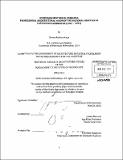| dc.contributor.advisor | James Wescoat. | en_US |
| dc.contributor.author | Rutkouskaya, Hanna (Hanna Nikolaevna) | en_US |
| dc.contributor.other | Massachusetts Institute of Technology. Dept. of Architecture. | en_US |
| dc.coverage.spatial | a-uz--- e-ur--- | en_US |
| dc.date.accessioned | 2012-09-13T18:53:38Z | |
| dc.date.available | 2012-09-13T18:53:38Z | |
| dc.date.copyright | 2012 | en_US |
| dc.date.issued | 2012 | en_US |
| dc.identifier.uri | http://hdl.handle.net/1721.1/72818 | |
| dc.description | Thesis (S.M.)--Massachusetts Institute of Technology, Dept. of Architecture, 2012. | en_US |
| dc.description | Page 96 blank. Cataloged from PDF version of thesis. | en_US |
| dc.description | Includes bibliographical references (p. 93-95). | en_US |
| dc.description.abstract | This thesis focuses on how Bukhara's architectural heritage was interpreted and redefined by local architectural professionals between 1965 and 1991, a period characterized by heightened interest in architectural heritage and increased restoration of monuments. Architectural professionals criticized the earlier Soviet "nihilist" treatment of historical Bukhara in the 1920s-1950s and instead framed their work as an attempt to correct earlier mistakes. This thesis analyzes restoration and architectural projects proposed for Bukhara by examining images and text available in the professional Uzbek SSR architectural journal, Architecture and Construction in Uzbekistan (ACU). Using these journals, this thesis illustrates how architectural professionals engaged in creating new meanings for Bukhara's historical environment, as an important part of the new identity construction shaped in conditions of Soviet nation-building and strengthening Uzbek national sentiment. Increasingly alienated from the Soviet center, local professionals developed a renewed understanding of Bukhara's urban heritage in the 1960s-1970s. Marked by almost utopian excitement, their projects envisioned Bukhara as a place of recreation, leisure, and tourism, that spoke to the larger desire to belong to the modern world by matching the modern role assigned to heritage. With tourism finally possible in the 1980s, Bukhara's historical monuments were subjected to "museum-ification" and prepared for display. The importance of displaying national heritage in late Soviet Uzbekistan was in summary a shy attempt, rehearsal, and preemptor of what was yet to come in the future, when in 1991 trans-republic boundaries were replaced by the contemporary ethnically-defined national borders, and an imaginary other, created as a part of the identity construct in the 1980s, eventually became a real global other. | en_US |
| dc.description.statementofresponsibility | by Hanna Rutkouskaya. | en_US |
| dc.format.extent | 96 p. | en_US |
| dc.language.iso | eng | en_US |
| dc.publisher | Massachusetts Institute of Technology | en_US |
| dc.rights | M.I.T. theses are protected by
copyright. They may be viewed from this source for any purpose, but
reproduction or distribution in any format is prohibited without written
permission. See provided URL for inquiries about permission. | en_US |
| dc.rights.uri | http://dspace.mit.edu/handle/1721.1/7582 | en_US |
| dc.subject | Architecture. | en_US |
| dc.title | Redefining historical Bukhara : professional architectural vision of the national heritage in late Soviet Uzbekistan (1965 - 1991) | en_US |
| dc.title.alternative | Professional architectural vision of the national heritage in late Soviet Uzbekistan (1965 - 1991) | en_US |
| dc.title.alternative | Redefining heritage in Bukhara : professional architectural vision of the national heritage in late Soviet Uzbekistan (1965 - 1991) | en_US |
| dc.type | Thesis | en_US |
| dc.description.degree | S.M. | en_US |
| dc.contributor.department | Massachusetts Institute of Technology. Department of Architecture | |
| dc.identifier.oclc | 806349719 | en_US |
